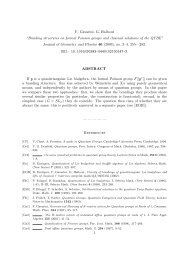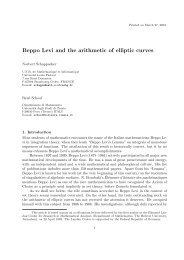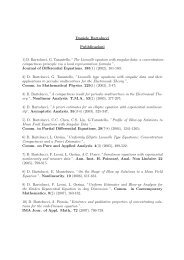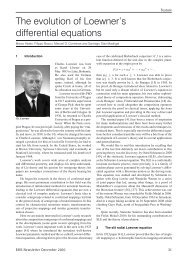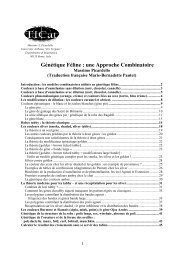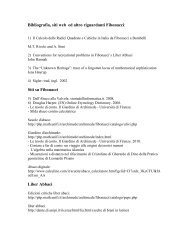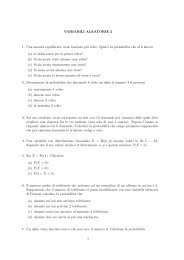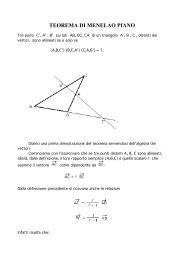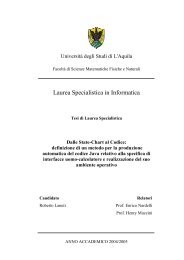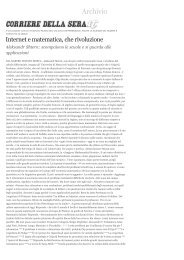Onde e Calore - Dipartimento di Matematica
Onde e Calore - Dipartimento di Matematica
Onde e Calore - Dipartimento di Matematica
Create successful ePaper yourself
Turn your PDF publications into a flip-book with our unique Google optimized e-Paper software.
Paolo Perfetti, <strong>Dipartimento</strong> <strong>di</strong> matematica, II Università degli Stu<strong>di</strong> <strong>di</strong> Roma, facoltà <strong>di</strong> Ingegneria<br />
9. Esempi<br />
1) Risolvere l’equazione:<br />
u tt − u xx = sin x, 0 < x < π, t > 0<br />
u(x, 0) = 0, u t (x, 0) = 0, 0 ≤ x ≤ π<br />
u(0, t) = 0, u(π, t) = 0, t ≥ 0<br />
È una equazione non omogenea con con<strong>di</strong>zioni al bordo nulle per cui la soluzione si scrive<br />
seguendo (2.2) (2.3) da cui, tenendo conto che in questo caso ϕ(x) = ψ(x) = 0 e che f(x, t) =<br />
sin x<br />
+∞<br />
(u ′′<br />
e quin<strong>di</strong><br />
k=1<br />
k + k2 u k ) sin kx = sin x<br />
k = 1, u ′′<br />
k + uk = 0 =⇒ uk (t) = ak cos kt + bk sin kt<br />
k = 1, u ′′<br />
1 + u1 = 1 =⇒ uk (t) = a1 cos kt + b1 sin kt + 1<br />
La con<strong>di</strong>zione iniziale u(x, 0) = 0 impone a k = 0 se k = 1, mentre a 1 + 1 = 0 dà a 1 = −1. La<br />
con<strong>di</strong>zione iniziale u t (x, 0) = 0 impone b k ≡ 0 ed alla fine la soluzione è<br />
u(x, t) = sin x(1 − cos t)<br />
Siccome la <strong>di</strong>somogeneità sin x è stazionaria, possiamo anche procedere nel modo che segue (ve<strong>di</strong><br />
(2.4) e seguenti). Scriviamo u(x, t) = U(x) + V (x, t) da cui<br />
Risolviamo l’equazione al bordo<br />
ossia<br />
V tt − V xx = sin x + U xx , 0 < x < π, t > 0<br />
U(x) + V (x, 0) = 0, V t (x, 0) = 0, 0 ≤ x ≤ π<br />
U(0) + V (0, t) = 0, U(π) + V (π, t) = 0, t ≥ 0<br />
U xx = − sin x, 0 < x < π,<br />
U(0) = 0, U(π) = 0<br />
=⇒ U(x) = a + bx +<br />
x<br />
0<br />
(9.1)<br />
(9.2)<br />
(9.3)<br />
y<br />
dy dz sin z (9.4)<br />
0<br />
U(x) = a + bx + sin x, U(0) = 0 ⇒ a = 0, U(π) = 0 ⇒ bπ = 0 ⇒ b = 0<br />
e quin<strong>di</strong> U(x) = − sin x. Il sistema (9.3) <strong>di</strong>venta<br />
V tt − V xx = 0, 0 < x < π, t > 0<br />
V (x, 0) = − sin x, V t (x, 0) = 0, 0 ≤ x ≤ π<br />
V (0, t) = 0, V (π, t) = 0, t ≥ 0<br />
Usiamo la (1.23) e quin<strong>di</strong> V (x, t) = − 1<br />
2 (sin(x − t) + sin(x + t) = − sin x cos t e sommando con<br />
U(x) abbiamo u(x, t) = sin x(1 − cos t)<br />
21/novembre/2010; esclusivamente per uso personale, è vietata ogni forma <strong>di</strong> commercializzazione 17<br />
(9.5)



